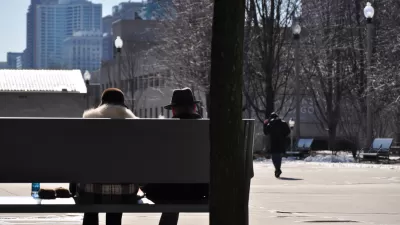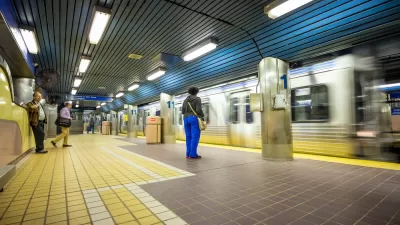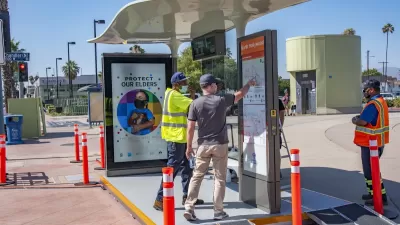All over the country, sorry bus stops lack seating. Studies show that deficiency can depress ridership, some motivated citizens are looking to change that.

Any frequent bus rider knows all stops aren’t created equal. Sorry bus stops can leave riders waiting without shelter or the all-important place to sit. While benches are an inexpensive amenity for cities to provide, many don’t, that can be where enterprising citizens come in.
Non-for-profit Tiny WPA in Philadelphia designed an accessibility friendly bench. "They don’t look like your typical benches: Part of the seat is raised higher than normal and angled upwards, with a vertical pole attached, to assist older adults in sitting down and standing up," Linda Poon writes for CityLab. In Los Angeles, one concerned citizen has been installing difficult-to-remove benches that wrap abound poles. These benches went in without city approval, and the artist was anonymously interviewed in the Los Angeles Times.
The Better Bus Coalition of Cincinnati has also installed guerrilla benches, chaining them to sign posts with the message “This bench supports bus riders more than the city does.” Lack of seating at bus stops has long been an issue in the city "where the city council, citing improper maintenance, began removing ad-sponsored benches back in 2006," Poon writes.
Comfortable bus stops are important, because they improve the quality of the experience for riders, but they also have other benefits. "Better amenities can boost ridership, according to a Transit Center report and, given the worrying state of bus use nationwide, installing better benches should be a low-cost way for cities to address a low-hanging fruit," Poon argues.
FULL STORY: Take a Seat: 5 Brilliant Bus Stop Fixes

Maui's Vacation Rental Debate Turns Ugly
Verbal attacks, misinformation campaigns and fistfights plague a high-stakes debate to convert thousands of vacation rentals into long-term housing.

Planetizen Federal Action Tracker
A weekly monitor of how Trump’s orders and actions are impacting planners and planning in America.

In Urban Planning, AI Prompting Could be the New Design Thinking
Creativity has long been key to great urban design. What if we see AI as our new creative partner?

Portland Raises Parking Fees to Pay for Street Maintenance
The city is struggling to bridge a massive budget gap at the Bureau of Transportation, which largely depleted its reserves during the Civd-19 pandemic.

Spokane Mayor Introduces Housing Reforms Package
Mayor Lisa Brown’s proposals include deferring or waiving some development fees to encourage more affordable housing development.

Houston Mayor Kills Another Bike Lane
The mayor rejected a proposed bike lane in the Montrose district in keeping with his pledge to maintain car lanes.
Urban Design for Planners 1: Software Tools
This six-course series explores essential urban design concepts using open source software and equips planners with the tools they need to participate fully in the urban design process.
Planning for Universal Design
Learn the tools for implementing Universal Design in planning regulations.
Gallatin County Department of Planning & Community Development
Heyer Gruel & Associates PA
JM Goldson LLC
City of Camden Redevelopment Agency
City of Astoria
Transportation Research & Education Center (TREC) at Portland State University
Jefferson Parish Government
Camden Redevelopment Agency
City of Claremont





























